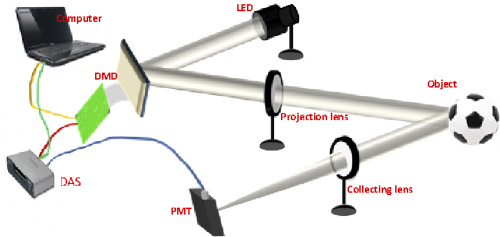
A research team from the Hefei Institutes of Physical Science (HFIPS) of the Chinese Academy of Sciences (CAS) has proposed a new anti-motion blur single-pixel imaging method for fast-moving objects. This method makes use of the advantages of wide spectrum and high sensitivity of single-pixel detector and contributes to breaking through the bottleneck of single-pixel imaging of fast-moving objects.
This research was selected as the Editor's Pick on Optics Letters.
Based on previous proof-of-principle capturing motion information and imaging information, "this study changes the traditional notion that single-pixel imaging is only suitable for static or slow-moving objects," said WANG Yingjian, who led the team.
Single-pixel imaging technique has made significant progress in imaging static or slow-moving objects, and has been widely recognized. However, for fast-moving objects, motion blur is the main bottleneck of single-pixel imaging in practical engineering applications.
In order to solve this problem, the researchers proposed a multi-task tackling system for moving target tracking and imaging. A small amount of information detected by the single-pixel detector was used to locate and track the moving targets. With the increase of detection information over time, imaging of fast-moving objects and motion blur correction were realized synchronously.
The proposed technology system fully exploits the characteristics of single-pixel detection and realizes rapid positioning, clear imaging, and recognition of fast-moving targets according to the characteristics of the system's detection information data stream. The proposed technology roadmap "tracking before imaging" subverts the time-sequence relationship of imaging before tracking in the traditional technical method.
"The experimental results are encouraging," said Dr. Matthew Edgar, formerly from University of Glasgow, "and I am sure future work in this area will compare and contrast the efficacy of the author's approach with other single-pixel sampling and reconstruction methods for real-world applications where there is rapid and dynamic motion of objects in the scene. The research resolves one of the key challenges of this approach for faithfully and efficiently reconstructing the image information when objects are in motion during sampling."
"This feat is accomplished by structurally modulating light illumination the object from which a tomographic projection is obtained. With this strategy, rapid tracking of an object is demonstrated. Because more limited information is obtained using fast detectors and modulators, this approach has the potential to scale to very high speeds," said Prof. Randy Bartels from Colorado State University.
Relevant research of this study was supported by the Youth Innovation Promotion Association of CAS and the Key Laboratory Fund for Scientific and Technological Innovation of CAS.

Experimental system. DMD is for digital micromirror device, LED is for light-emitting diode, PMT is for photomultiplier tube, and DAS is for data-acquisition system. (Image by SHI Dongfeng)

86-10-68597521 (day)
86-10-68597289 (night)

52 Sanlihe Rd., Xicheng District,
Beijing, China (100864)

